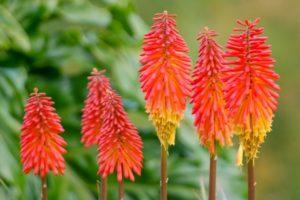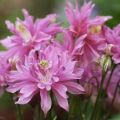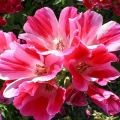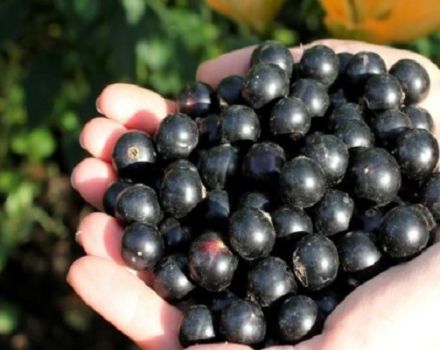Rules for planting and caring for aquilegia in the open field
It is impossible to imagine a spring flower bed without soft blue or lilac bell-shaped flowers with long spurs. We are talking about an aquilegia that blooms in May, planting and caring for this crop does not require too much effort. The plant is sown on a flower bed in autumn, and in spring, starting in March, seedlings are grown. Aquilegia tolerates all the vagaries of the weather and blooms from May to July.
Description and features
Aquilegia is a perennial herbaceous crop from the Buttercup family. This plant is also called the catchment area, and among the people - a bell, an eagle, boots, a spur, doves. Translated from Latin, aquilegia means - collecting water. Raindrops roll down the leaves into the soil, as their surface is covered with a water-repellent film.
Aquilegia is often found in meadows and forests of North America and Eurasia; it grows in the Sayan Mountains, Altai, and the Urals. Garden hybrid varieties are used to decorate flower beds. It is a medicinal plant with a sedative effect, but when fresh is poisonous.
Aquilegia grows up to 40-80 centimeters in height. Forms a sprawling bush with a lush rosette of leaves at the base and long, erect, strongly branching stems, on the tops of which there are flowers. The culture has a taproot.
The leaves below are long-petiolate, bluish-green, ternate, above, sessile or short-petiolate, simple or trifoliate. In late summer or autumn, after the end of flowering, new leaves appear. Then they overwinter and die off in early spring. In their place, young leaves grow again.
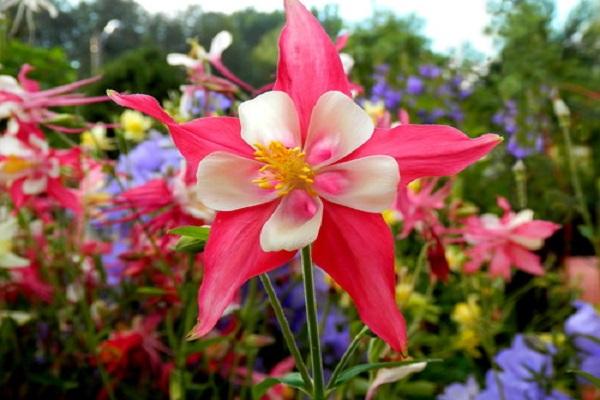
The culture blooms from May to July. The aquilegia flower, depending on the species, can be simple or double, with yellowish stamens in the middle.In shape, a simple flower looks like a bell with 5 petals, 5 sepals and spurs, in which nectar accumulates. The size is 4-6 centimeters. Flowers - single or collected in inflorescences of 2-3 pieces, often drooping. There are varieties without spurs (Chinese and Japanese varieties). Flowers can be snow-white, blue, yellowish, pale purple, crimson, multi-colored.
After pollination, in place of the flowers, a fruit is formed - a many-leafed, resembling a box. Inside there are many small black seeds. They remain viable for no more than 1 year.
Seeds can be sown directly into the ground (in autumn).
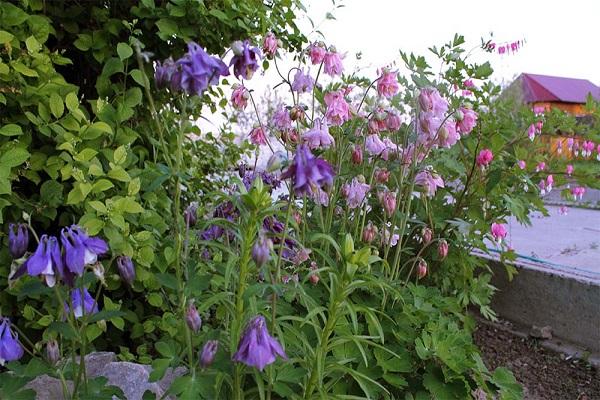
Kinds
There are about 100 types of aquilegia. No more than 35 varieties are cultivated. All types are divided into European and North American.
Alpine
Aquilegia growing in forest and alpine regions. It is listed in the Red Book of many European countries. It is a perennial herb that grows up to 40 centimeters in height. Flowers - large, single or collected in small inflorescences, deep blue or pale blue with a white border, like a bell, have curved spurs.
Ordinary
Perennial, used for breeding new varieties. In aquilegia, a branched peduncle stem grows up to 30-70 centimeters in height. A lush rosette of long-petiolate trifoliate leaves is formed at the base. Aquilegia blooms with blue, pinkish, lilac, sometimes white, bell-shaped flowers with curved spurs.
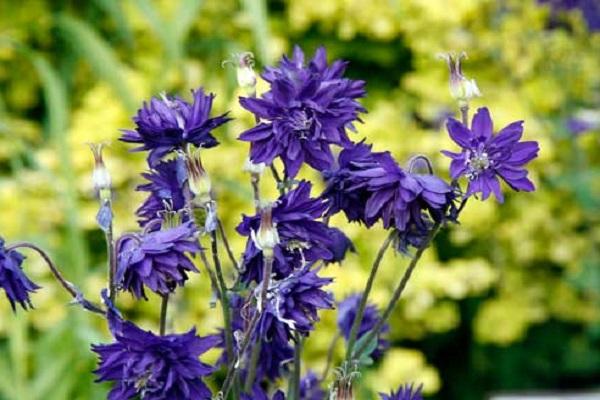
Fan-shaped
Perennial inhabiting rocks. The peduncle stem grows up to 15-50 centimeters in height. A compact rosette of fan-shaped, trifoliate leaves is formed at the root. Flowers - lilac-blue, white at the edges, bell-shaped, with curved long spurs. A winter-hardy culture that blooms in May.
Hybrid
This species includes hybrids created by breeders. Most of the new varieties are obtained by crossing European and North American species. Hybrids are distinguished by a longer flowering period, flower shape and color, resistance to disease and adverse weather conditions.
Canadian
This aquilegia is native to North America and grows on mountain slopes. Forms a spreading bush up to 60 centimeters high. Solitary, up to 4.5 centimeters in diameter, drooping, yellow flowers have pinkish sepals and spurs and long, dropping stamens.
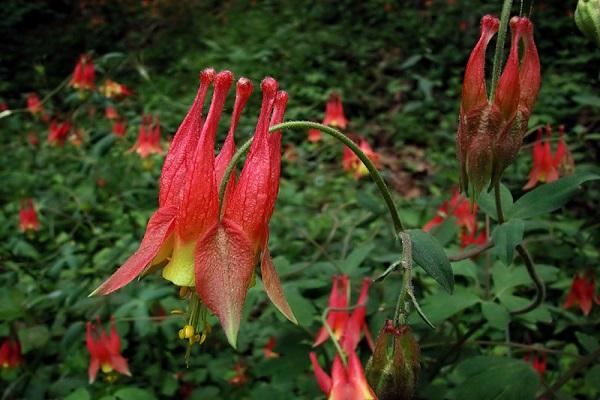
Dark
This aquilegia is native to the Alps and the Apennines. Plant height - 30-80 centimeters. It blooms with dark purple or deep blue bell-shaped flowers with curved spurs.
Skinner
Wild forms grow in mountain forests in the southern United States. It is a herbaceous perennial with a stem height of 60-70 centimeters. The yellow flowers, covered with pink sepals on top, have small reddish spurs. Heat-loving species, blooms in August.
Golden-flowered
The culture is native to the southern regions of America. Herbaceous perennial with erect stems up to 1 meter high. It has a rich yellow, 5-petal, bell-like flowers with pale sepals and curved spurs.
Olympic
Perennial native to the Caucasus and Asia Minor. This plant has large light blue flowers with spurs, covered with a more intense color with long sepals. The culture grows up to 40-60 centimeters. Blooms from May to June (30 days).

Popular varieties
Based on the main types of aquilegia, often by crossing them, a huge number of new varieties have been bred. Crop different in height and shape, color of flowers are used to decorate flower beds, borders, grown as a potted plant or for cutting.
Barlow Rose
A kind of ordinary aquilegia. Herbaceous perennial up to 60 centimeters high. It has large (up to 5 centimeters), densely double flowers of a pale pink color. It blooms twice - at the very beginning and at the end of summer. Openwork leaves retain their green color until the very frost.
Winky
A hybrid characterized by long and abundant flowering. Grown in open beds and in pots. It has a compact bush 0.50 meters high. At the base, a dense, lush rosette of leaves grows, over which erect peduncles with upward-turned flowers of a dark pink, white-purple color rise. Winter-hardy variety.
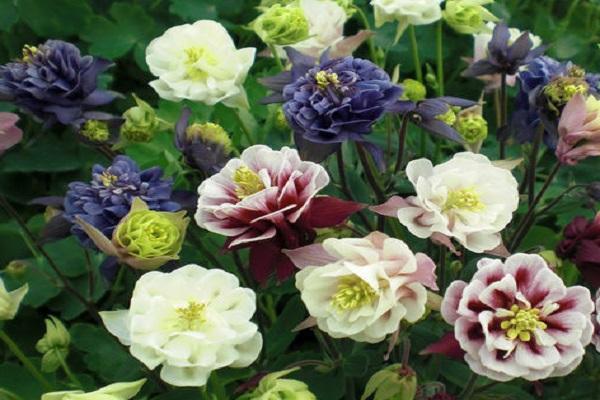
Blue Star
A tall, spreading bush with fan-shaped green leaves diverging from the base in different directions. The flowers are white-blue, drooping, bell-shaped, with 5 petals and 5 sepals and small curled spurs.
Lantern
Aquilegia variety, bred on the basis of the Canadian species. Above a lush rosette of bluish-green basal leaves, erect peduncles with orange-pink drooping flowers, similar to lanterns, rise.
Citrina
Aquilegia with lemon yellow, simple flowers with spurs. Sepals are much longer than petals, they diverge in different directions. In the middle of the flower is a bunch of yellowish stamens.
Alba
Aquilegia with a lush openwork skirt of leaves at the base and high stems, peduncles. Flowers - white, drooping, bell-shaped, with long, diverging sepals and curled spurs.
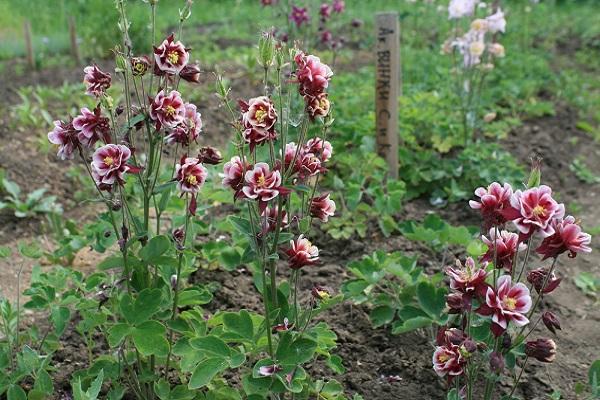
Music F1
A compact bush up to 0.50 meters high, with a lush rosette of basal, openwork, bluish-green leaves. The flowers are creamy yellow (bluish, pink), simple, with long sepals and spurs.
Origami f1
A low bush (up to 35 centimeters) with a fluffy skirt made of openwork leaves. The flowers are simple, with long spurs, often two-colored (white-blue, pink-burgundy).
Clementina
Aquilegia with double pale pink (snow-white, deep blue) flowers, similar to asters. The flower heads are turned up.
Winki
A low compact plant (up to 50 centimeters) with a lush rosette of openwork basal leaves. Flowers "look" up, as if winking at everyone. Aquilegia blooms with delicate red or purple flowers with a diameter of 5.5 centimeters.
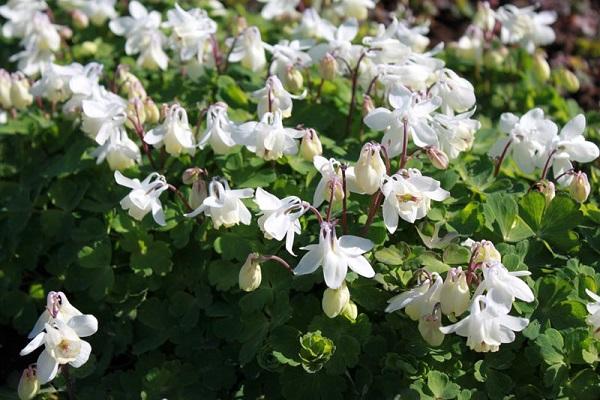
Ice blue
A low bush (up to 15 centimeters) with a raised rosette of openwork leaves. The flowers are simple, drooping, blue-white or purple-cream.
Crimson Star
Hybrid aquilegia. The stem grows up to 60 centimeters high. It has red flowers with a white center.
Biedermeier
A low-growing, decorative hybrid, the stem of which grows to 0.30-0.40 meters in height. Flowers - double, two-colored (red-yellow, white-blue).
Birds of paradise
The bush of this culture is high (up to 0.80 meters). The flowers are large, double, of all sorts of colors, like asters.
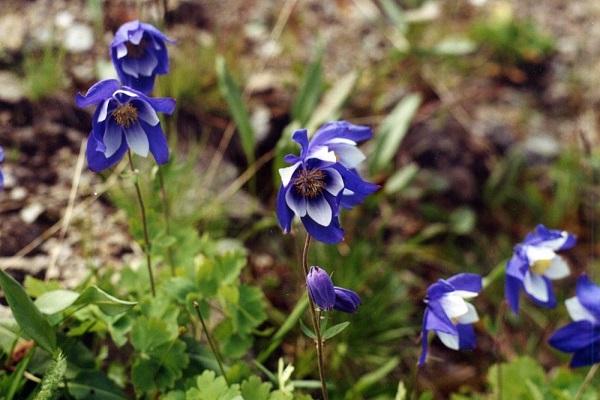
Giant McCana
Hybrid culture. It has a high (up to 1.2 meters) stem. Flowers of all kinds are large, rarely drooping, have long spurs.
Nora Barlow
A plant with two-colored or monochromatic large flowers similar to dahlias. Flowers can be pale pink, deep red, dark purple.
Yellow crystal
This species of aquilegia has a tall (up to 0.80 centimeter) stem. The flowers are simple, deep yellow in color, with long sepals and spurs.
Ruby port
A variety bred on the basis of ordinary aquilegia. Forms a lush bush with dense foliage at the base. The stems grow up to 0.9-1.1 meters. Flowers are double, large (up to 4.5 centimeters), dark red. Grown to decorate flower beds or cut.
Columbine
Aquilegia with large double aster-like flowers. The flower heads are turned up. They can be snow-white, reddish, purple in color.

How to sow seedlings
Aquilegia is grown in 2 ways - seedling and non-seedling. For seedlings, seeds are sown in spring or autumn. In any case, the seeds must first be stimulated with cold for at least 1 month. Hybrid store varieties do not require preliminary preparation or processing.
Spring sowing
In the spring, in mid-March, aquilegia seeds are sown for seedlings in boxes with a nutrient substrate. They emerge in 7-16 days.
Preparation of soil and containers
To grow aquilegia seedlings, they buy a substrate for flowering plants or prepare a soil mixture on their own. Soil composition: turf soil, compost (humus), sand (all ingredients are taken in equal proportions). Small boxes or pots with a drainage hole are suitable for growing seedlings.
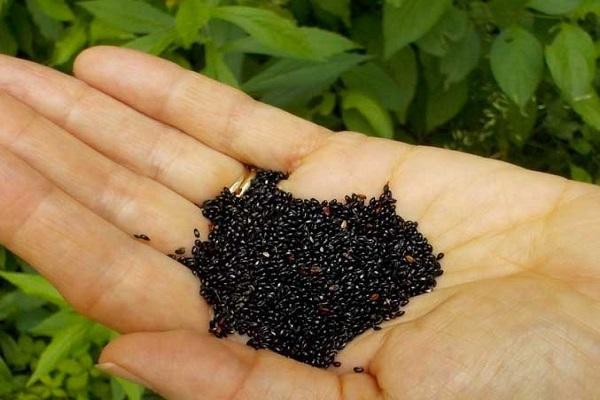
Preparing planting material at home
Seeds need cold stratification before planting. This pre-sowing treatment accelerates seed germination. In the refrigerator, on a shelf with vegetables, the seed is kept for 1 month. Then the seeds of aquilegia are soaked in water, after which they are germinated for several days in the light at a temperature of 25 degrees Celsius.
How to plant
Seeds of aquilegia are evenly distributed over the surface of the moistened substrate, then sprinkled with earth and covered with a transparent film until germination. From time to time, the earth needs to be moistened. Boxes with sown aquilegia seeds are kept indoors at a temperature of 16-18 degrees Celsius.
Autumn sowing
For aquilegia, autumn sowing with freshly harvested seeds is more preferable. In this case, the seeds undergo natural stratification. Aquilegia seeds are sown in containers with a fertile soil mixture. The boxes are taken out into the street and buried in the garden. They should be there all winter.
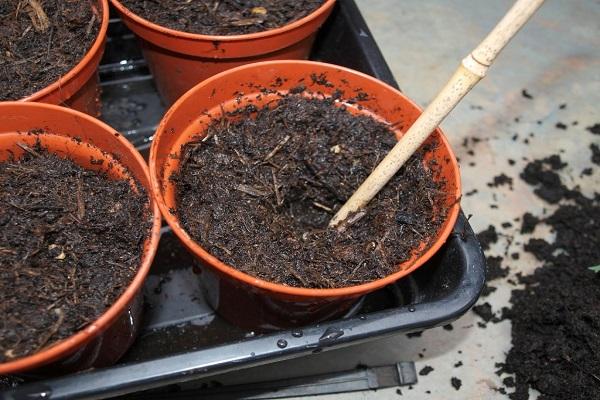
How to prepare the ground
For sowing, you need to take garden or sod land mixed with humus, peat and sand. All components are taken in equal proportions. The ground must first be disinfected with a fungicidal solution or potassium permanganate.
Landing
Seeds of aquilegia are not very densely scattered over the loosened, moistened earth, sprinkled with soil 0.5 centimeters on top. Before frost, crops are mulched with peat or humus.
Timing
Sowing seeds is carried out in the middle of autumn (early October). In the spring, when shoots appear, the seedlings are carefully removed from the box and immediately planted in a permanent place.
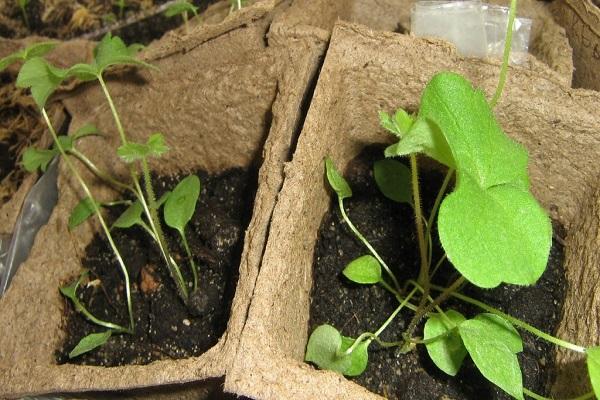
Growing
Aquilegia seeds sown in March for seedlings germinate after 7-16 days. The growing seedlings need to be regularly looked after, and at the end of May - transferred to the flower bed.
Light and temperature conditions
Seedlings need to be provided with a temperature of 16-18 degrees Celsius. Daylight hours should be 10 hours. If it's too hot or dark, the seedlings will stretch out a lot.
Watering
Growing aquilegia seedlings should be regularly (moderately) irrigated with water. It is important to ensure that the soil in the box does not dry out. It is not recommended to fill the seedlings with water, otherwise they will get sick with a black leg and wither.
Dive
The grown seedlings of aquilegia must first be thinned out, leaving only the strongest in the box. After 4-6 weeks, when 2 true leaves appear on the seedlings, the plants dive into separate containers (peat cups).
During the dive, the root is carefully straightened in the hole, do not bend or break.
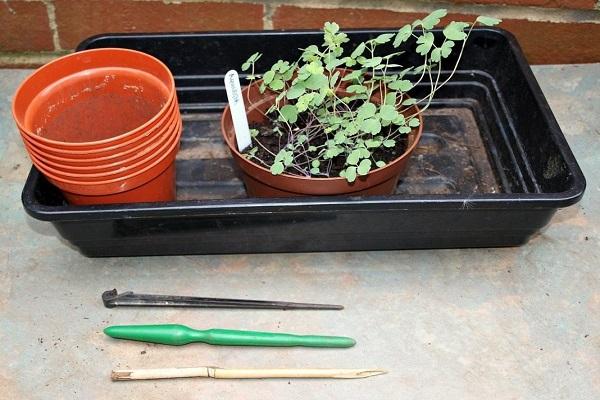
Landing in open ground
Seeds sown in early May or seedlings planted closer to summer in the first year will give only a lush, root rosette of leaves. In the second spring, several peduncles will appear. Abundant flowering of aquilegia can be obtained only in the third season. Each flower blooms for 5-10 days, hybrids take longer - up to 20 days. The period of full flowering of one culture is about 30 days.
Seat selection
It is better to plant Aquilegia in a well-lit area. Some varieties prefer light partial shade, in such places they will bloom longer.
Soil requirements
Aquilegia prefers neutral or slightly acidic, light, sandy loam or loamy soil. It is advisable to dilute too clayey soil with peat and sand, and add a little humus or compost to the poor one.
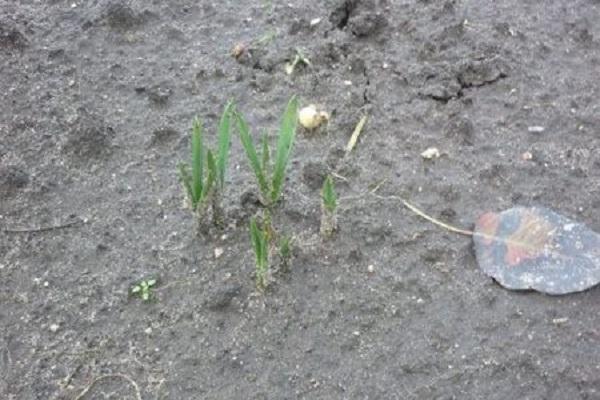
Timing
Seeds are sown on a flower bed in early May. The seedlings are transferred - at the end of May, when the air warms up to 15-18 degrees Celsius.On seedlings grown in 1.5-2 months, there should be 5-6 true leaves, the size of the shoots should be 10-20 centimeters. Such plants will bloom only in the second year.
Landing scheme
Pre-grown aquilegia seedlings are planted in prepared holes, at a distance of 25-30 centimeters from the neighboring culture. Plants from which they want to get seeds are planted away from relatives to avoid cross-pollination.
Sowing before winter
Purchased hybrid seeds and self-collected seed can be sown on a flower bed in autumn. During the winter, the seeds will undergo natural stratification.
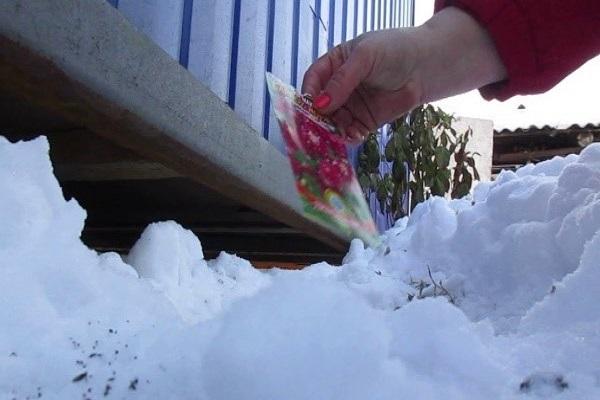
Preparing the garden
Previously, the soil must be dug to a depth of 20 centimeters. Add a little rotted manure or compost to the soil (half a bucket per 1 square meter of land).
How to sow
Seeds are sown sparsely, in loosened and pre-moistened soil. Sprinkle with soil 0.5 centimeters on top.
How to close the garden
Before frost, the aquilegia planting is covered with a thick layer of peat or humus. In early spring, the mulch is removed and the peduncles are allowed to germinate.
Timing
In autumn, seeds are sown in an open flower bed in late September or early October. It is advisable to sow the seeds before November, that is, before the soil finally freezes over.
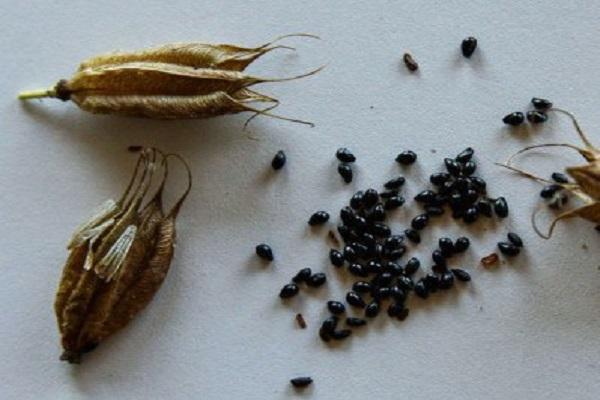
Care
Aquilegia is an unpretentious and unpretentious culture. However, with regular watering, combined with periodic fertilization, it will bloom longer and more abundantly.
Loosening and weeding
After the rains, the soil near the bush must be loosened so that a soil crust does not form, which interferes with the circulation of oxygen. It is imperative to remove the weeds that have appeared on the flower bed so that they do not take away nutrients.
Top dressing
In order to grow a lush bush, aquilegia must be fed in early spring with humus (0.5 kilograms for 1 culture) or azofoska (1 teaspoon under a bush). In early June, it is necessary to apply potassium-phosphorus fertilizers. In August, the bush can be fed with phosphorus supplements.
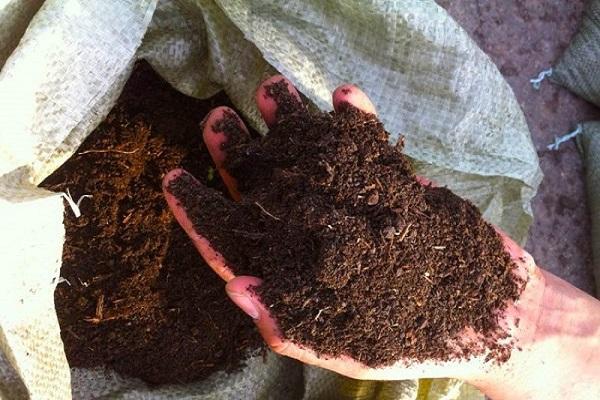
Moderate watering
Aquilegia tolerates drought well, but for abundant and long flowering in dry season, the plant needs to be watered. If rainfall occurs regularly, watering is not necessary.
Garter
Tall varieties can be tied to a support. For garter use wooden sticks, bamboo, twine.
Powder roots
Every year you need to add some fertile soil under the bush. This is done in order to sprinkle the roots emerging on the surface.
Removal of dry peduncles
Fading flowers must be constantly removed, without giving them the opportunity to form a seed capsule. In this way, a longer flowering of the aquilegia can be achieved. If the plant is grown for the seeds, the flowers are not touched, the seeds are allowed to ripen. Dry peduncles are removed in the fall, after collecting the seeds. They are cut to the level of the root rosette of leaves.
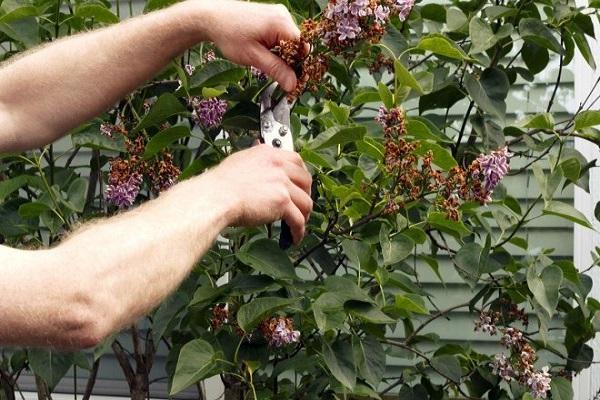
Pruning after flowering, preparing for winter
After flowering, the flower stalks of hybrid crops must be cut off along with the immature boxes, since their seeds are not used for sowing. Before wintering, adult bushes are usually not insulated. However, it is advisable to cover young plants with spruce branches or dry leaves. A layer of compost or humus is poured under bushes older than 5-6 years before wintering.
Transfer
Adult aquilegia does not tolerate transplantation. The plant is transplanted only in extreme cases. For example, at the age of 5-6 years, during vegetative reproduction (division of the bush).
Diseases and pests
In cool and damp weather, weakened plants growing on poor soil can become sick. In the heat, aquilegia is often attacked by pests..
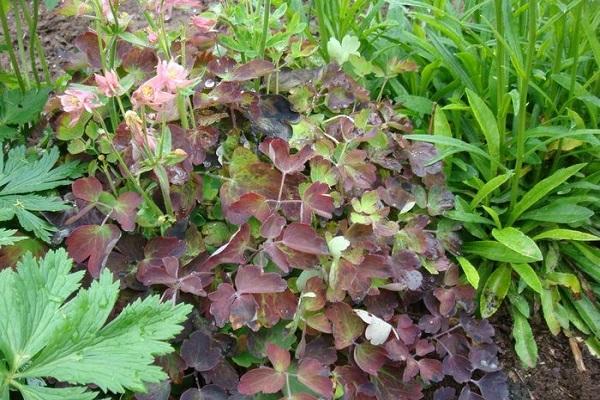
Powdery mildew
Fungal infection. Signs: A white fluffy bloom appears on the leaves and stems. As a preventive measure, the plant is sprayed in the spring with a solution of a fungicide (Fitosporin-M) or colloidal sulfur.
Rust
A fungal disease in which numerous orange spots appear on the underside of the leaves. Subsequently, the affected surface dries up and the plant withers. For prevention, the bushes are sprayed with a solution of copper sulfate, colloidal sulfur or a fungicide.
Gray rot
Fungal infection that appears on leaves and peduncles in damp weather in the form of gray mold. For prevention, fungicides are used (Topaz, Champion).
Nematodes
These are tiny worms that live in the earth. They feed on roots and stems. In the affected plants, leaves turn yellow and curl, buds dry up. Nematocides (Carbation, Terakur) save from nematodes.
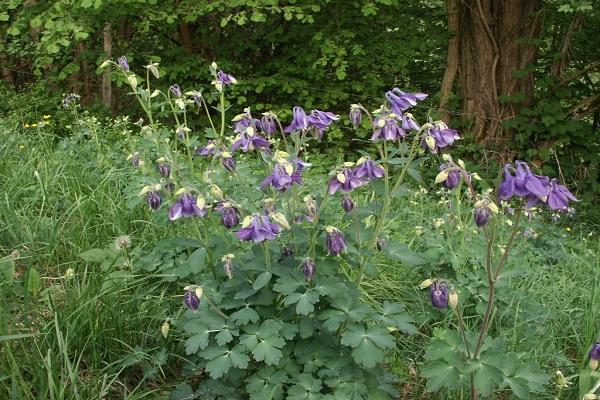
Aphid
Tiny light green soft-bodied insects that live on the back of the leaves and feed on their sap. They cause yellowing and drying of leaves, poor flowering. Spraying with insecticides (Karbofos, Aktellik) is saved from aphids.
Spider mite
A small red insect that lives on the back of the leaves and weaves a white cobweb. It feeds on plant sap, which causes the leaves to become covered with yellow spots and dry out. Acaricides (Kleschevit, Iskra) save from ticks.
Reproduction methods
Aquilegia propagates by seed method or vegetatively. Hybrid seeds are best purchased from a specialist store.
Cuttings
In the spring, young, who have not yet had time to dissolve the leaves, the first shoots are broken out at the base, placed in a Heteroauxin solution and rooted in a moist sand-peat mixture. Cover the cuttings with a transparent jar or plastic bottle. Rooting takes place over 20 days.

Dividing the bush
In early spring (in April) or after flowering in autumn (in September), the bush is divided. For propagation, an old plant is chosen at the age of 5-6 years. The bush is divided into 2-3 parts. Each section should have healthy roots and a couple of renewal points. Ground leaves can be cut off, leaving no more than 2-3 leaves on each section. The divided bush takes root long and painfully in a new place due to root damage, and does not even bloom in the first year.
Self-collection of seeds and their selection for sowing
The seeds are harvested when they are fully ripe. You can put bags on the boxes so that the seeds do not spill out of them without permission. True, with the seed method of reproduction, it is not always possible to obtain a new plant identical to the mother. Varietal characteristics in this case are not preserved. It is better to buy ready-made hybrid seeds from the store.
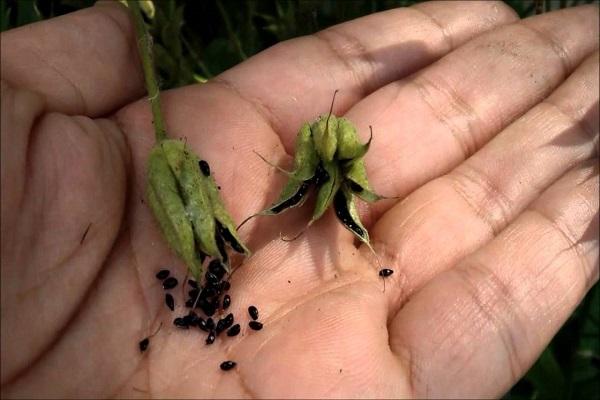
How and for what to use distillation
Aquilegia is often cut for spring holidays. To do this, in the fall, the bush is dug up, divided and planted in pots. For some time, the containers should stand in the cold in a dark place. In January, they are brought into a warm and well-lit room. A stressful situation awakens the plant, and it blooms by March 8th.
Use in landscape design
Aquilegia is used to decorate flower beds, mixborders, rock gardens, and make flower arrangements. This flowering culture with a lush rosette of basal, openwork leaves looks great in single plantings. Aquilegia is combined with irises, lupins, bells, ferns, ornamental grasses.
Application in medicine
Aquilegia contains many biologically active components (alkaloids, flavonoids, tannins, tannins, vitamins, minerals). Thanks to them, this culture is used as a diuretic, sedative, anti-inflammatory, pain reliever. For medicinal purposes, all parts of the plant are used, they are plucked, dried, and tinctures or decoctions are made. It must be remembered that fresh aquilegia juice is poisonous.

